It Takes 6079 Words to Recount the Plot of 'Drive'
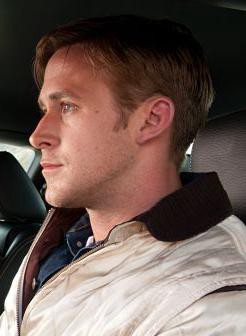
“He turns on a police scanner and also a Clippers — Raptors game on the radio (I know! Who cares about the Clippers? But be patient — all will be revealed), and takes some care to balance the volume of the two. He hears the break-in reported on the scanner but remains calm. He hears that units are being dispatched to the area, and still, he is unperturbed. One of the two robbers comes back but the other dallies, and the first robber is nervous, but Ryan Gosling is chill. You will notice that Ryan Gosling remains calm pretty much all the time. One wonders if his forbearance comes from his state of namelessness, which, while presumably of his own choosing, must also lead to some confusion (like later in the film, when he calls his neighbor’s seven-year-old and says, ‘It’s me,’ and the kid is like, ‘Hi,’ and Ryan Gosling is like, ‘Is your mother there?’ and the kid is like, ‘She’s talking to the police right now,’ and Gosling is like, ‘Well, tell her I called,’ which is all normal, but we’re left to wonder what the kid will tell her. ‘He called.’ ‘Who?’ ‘You know — him. The guy.’). Anyway, finally the other robber gets there and Ryan Gosling starts driving, and he’s listening to the police scanner and playing a cat-and-mouse game with the cops, who have gotten a report of a silver Impala (darn! shoulda just gone with a Mustang or something), which involves pulling behind a parked truck and killing the lights, hiding under an overpass to avoid the roving spotlight of a police helicopter, and, briefly, accelerating and doing crazy skid-turns to shake one cruiser that has actually turned its flashing lights on and started to give chase.”
— It may dismay you to learn that there are only 5787 more words in this extremely thorough recounting of the plot of the movie Drive
.
The Freakshow Galleries
Here you will find a collection of bizarre, misshapen creatures whose freakish aspects instantly induce revulsion and the instinct to look away. Also here.
The Dude From Whitesnake Is 60
Mr. David Coverdale, a vocalist from England, turns 60 today. I would have used the Whitesnake video of that chick doing the thing on top of the car, but it’s been a rough week and none of us need that song stuck in our head all day. You’re welcome. So here’s his best Robert Plant imitation instead. Anyway, happy birthday, dude from Whitesnake. (Also celebrating a birthday today: egg enthusiast Fay Weldon, who turns 80.)
On Urgency
Just off the top of your head, what would you say is “urgently needed” right now? Would it be this? Remember, there are no wrong answers!
'Confessions of a Shopaholic': If Patricia Highsmith Wrote Chick Lit
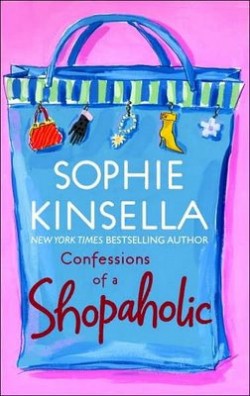
This isn’t Peyton Place, kids. Confessions of a Shopaholic isn’t even strictly “Classic,” but, as a reader pointed out last time, it’s 11 years old now, and, honestly, that makes it basically Jude the Obscure, right? It’s older than Facebook, so deal.
Confessions of a Shopaholic (or The Secret Dreamworld of a Shopaholic, if you’re from Jude the Obscure’s literary homeland) is the first in a series of six (!) novels following the excruciatingly useless Becky Bloomwood through her pointless, awful Hellmouth of a life, which, since there is No God, somehow rewards her again and again for her near-sociopathic narcissism and twittery charm. She is like a Balrog, but with accessories. She is the Void that stares back into us.
Also? Until yesterday? I had only read the first five books, and didn’t even know about Mini Shopaholic (it has bred, sweet Jesus). Rectified!
I love these books. I love everything about them. I love how Becky Bloomwood is completely devoid of sexuality: I imagine that she looks like a Ken Doll when she doesn’t have her adorable little pants on. I love how she learns nothing, ever, and is a worse person in each subsequent novel. These are the chick lit novels that Patricia Highsmith would have written, had she been born in a different time, and been forced to write books that could be sold with ribbon belts on the cover.
Do you remember the unfortunate novelist in Stephen King’s Misery? Do you remember how he wrote a jokey-spoof version in which his protagonist gets reamed by her German Shepherd for three hundred pages? Sometimes I imagine that Sophie Kinsella (who is really quite skillful; props to you, madam) has TWENTY SUCH BECKY BLOOMWOOD NOVELS sitting in a lockbox in her country home in the Cotswolds, which she drags out at intimate dinner parties for fabulous staged readings. And, in these novels, instead of humping dogs, Becky Bloomwood just casually kills people to get those things she covets (We covet what we see everyday). Scarves, darling little shoes, luggage. Sandwiches!
I digress.
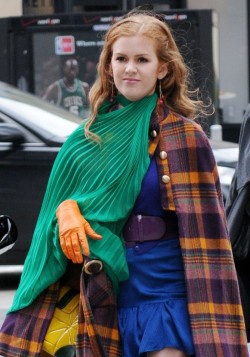
Becky Bloomwood is, obviously, mentally ill. While she’s probably not a sociopath — she just has a shopping addiction — she’s also a shitty person. When she rifles through the rich guy’s checkbook while he’s in the bathroom to figure out his spending habits? After coming thisclose to grifting him for five hundred pounds for a fake charity in remembrance of her fake dead aunt? The rich guy who reminds us so much of that sweet, feckless “Tom” fellow from Four Weddings and a Funeral? You can’t handle it. It’s like looking directly into the sun.
I, personally, greatly struggle when reading books about people making terrible decisions based on addiction. It’s not even their fault! They’re addicted, you know? But then I’m reading Bill Clegg’s memoir, right, and he’s supposed to fly to London for a series of meetings, and he’s in a cab on the way to the airport, and you’re all, DO NOT ASK THE CABBIE WHERE YOU COULD SCORE SOME CRACK, BILL, your writers need you, and the next thing you know, he’s holed up in a Hampton Inn, 20 minutes from Newark, doing a tremendous amount of crack, for several days. Well, every single page of Shopaholic is like that. Becky is holed up doing crack in a Hampton Inn for six books, her crack is just more… nice handbags.
And it drives you nuts! Becky, you say, you have to get right with yourself! You have to buy a Suze Orman book, and start opening your bills, and ranking them by interest rate, and paying them off. You need to brown-bag it! You need to get a real job.
But, whatever, it all works out. In that a rich man falls in love with her. Oh, sure, they make a token effort to show her making better decisions, but, ultimately, Luke Brandon is bailing her ass out. Mazel tov, Becky! So much easier than selling your eggs.
Is it terribly wrong, though, that this series exists? Or is it okay, because we all love Dexter so much and he’s a serial killer, and it’s very funny sometimes? Why don’t we add that to our Discussion Questions, k?
Things Becky Buys That Becky Doesn’t Need
• “that suit in Jigsaw”
• “dinner with Suze at Quaglinos”
• “that gorgeous red and yellow rug”
• “that skin brusher thing which I must use”
• “my gorgeous new matching knickers and bra with embroidered yellow rosebuds”
• “a gorgeous blue ceramic plant holder with little elephants going around it”
• “a sweet little silver notebook and pen to write down everything I spend”
• “a photograph album covered in William Morris print, an old-fashioned wooden jigsaw puzzle, a book of fashion photographs, and a fantastic ceramic teapot”
• Some fucking scarf from Denny and George that she doesn’t shut up about for three chapters, and is all shimmery and gray-blue
Discussion Questions
• Okay, seriously, did you see the movie? Because I DID NOT, out of general principle. It’s set in AMERICA? Bish, please. Let’s just move “Downton Abbey” to the Hamptons, amirite?
• Isn’t “Downton Abbey” amazing? You can talk about that here, if you’ve never read Shopaholic and don’t plan on it.
• If you didn’t have an inner life or a conscience, who would you kill, and why? What would your life look like?
• There’s always a possibility that someone reading “Classic Trash” actually lacks an inner life or a conscience. Could you tell us a little bit about it? Apparently, there are more of you people than we can possibly imagine!
• I just rotate a series of Gap t-shirts and Banana Republic jeans, so I can’t tell. Does Becky have good taste in fashion, or is this a Claudia Kishi thing, and you don’t notice until later?
• Did you ever do crack with Bill Clegg? Would you?
• I didn’t even get into the really fun part of the book, which is the determined, polite, increasingly frantic series of letters from her bank manager that begin each chapter. Derek Smeath! Aren’t those great?
• Remember when I said she was devoid of sexuality? I had forgotten the part where she attempts to straight-up date-rape a nice young man. “Thinking back, perhaps it look me longer than it should have to guess that he wasn’t playing ball, so to speak. In fact, he actually had to punch me in the face to get me off him — although he was very apologetic about it afterward.” Oh, young man. Please get some therapy and find the right words to describe your experience.
Nicole Cliffe is the proprietress of Lazy Self-Indulgent Book Reviews.
Political Games: Will Elizabeth Warren "Steal" Obama's Money?
Dem 2012 nightmare: Their base donates all of its money to Elizabeth Warren, $0 to ObamaWed Sep 21 18:43:08 via TweetDeck
daveweigel
daveweigel
HAHA, YAY, LET’S DO JUST THAT! Ya know? Maybe she can stand up to the hilarious deranged terror propaganda machine of Rick Perry, just by laughing in its ridiculous Bruckheimeresque face. Those kind of monsters usually evaporate when you realize they’re ridiculous.
Tomorrow! Planned Parenthood!
Ooh, tomorrow night is the super-fun Planned Parenthood benefit! $25 bucks! Sandra Bernhard and Lisa Lampanelli! Hilarity and reproductive rights! What else are you doing tomorrow? I figure you have no plans besides wine and possibly some resulting reproductive health service needs.
Embrace Your Prairie Looks And Make Some Applesauce
by Jaime Green
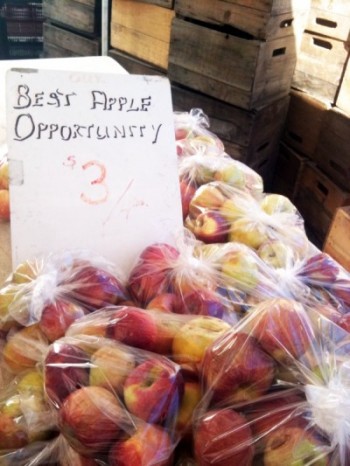
When I was a sophomore in college I was an incredibly cool and awesome girl, so my two best friends and I did what cool and awesome kids do in college and spent our spring break at Colonial Williamsburg. Don’t get me wrong: it was awesome. We were the only people there over 16 and under 40; one of us danced the minuet in a dance-styles demonstration, one of us caught the blacksmith’s eye, and all three of us got strange, bemused looks from the employees/waiters/reenactors who were the only people there around our own age. “What are you doing here?” the waiter in one tavern asked. We answered cheerily, spring break! And then he laughed, then shrugged and came back with spoonbread. Now, spoonbread — which is like corn bread but is pudding — was maybe the thing I’d been looking forward to the most about the trip, having remembered it from a trip my family took to Colonial Williamsburg when I was ten. That trip was over Passover, but on the second day we gave in to rolls and spoonbread, and it’s funny to look back now and think that that mattered.
One of the best things to do in Colonial Williamsburg — I mean, other than watch the blacksmith work and visit the haberdasher and attend the witch trial reenactment (casting votes in favor of conviction!) — is to shop. Not necessarily to buy things, but to wander between display racks and marvel and imagine. It’s no different than what you do in the period-appointed homes, except in the shops you’re allowed to touch and hold things. Everything’s for sale, but they seem less like commodities than artifacts. You could buy a pound of sugar in a supermarket, or you could take home a sugar cone in the Colonial style, from which you’ll daily scrape off your ration of crystals while thinking about the rum trade or Caribbean sugarcane or whatever. Or you can just hold the paper-wrapped cone in your hand in the shop, and think about doing that.
You can try on hats, and you may realize that, no matter how elegant your headwear, you have the face of a prairie girl. Of a peasant. Dainty bonnet, rough straw hat, coonskin cap: you look ready to head out to the fields. And just like spoonbread, these moments of imagining in the store can stay with you. They may even start to influence sartorial choices in the future: do you gravitate towards prairie-sleeved dresses and lace-up boots or fight against it lest you look like a Little House cosplayer? And what does it mean about your Eastern European ancestry that you look so at home in farm clothes? Is there some facial structure that is common to peasant classes, your great-greats in a Polish village having somehow evolved looks parallel to the Norwegian or whatever immigrants who peopled the farms of the American prairie? Why does your boss insist you look Irish?
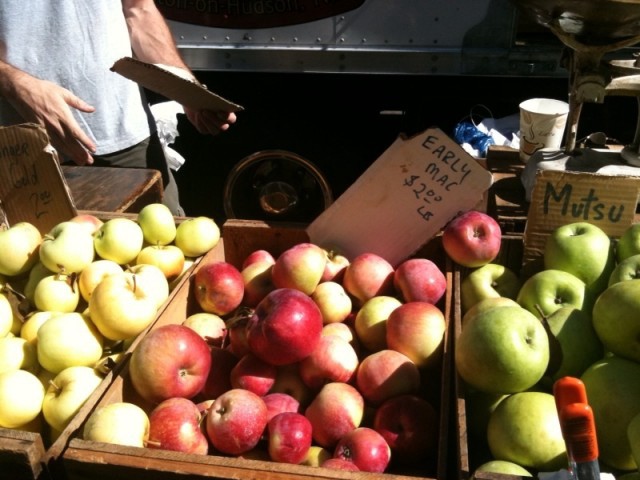
And then one fall afternoon I was making applesauce in my apartment, and a strange moment came over me. Maybe some subconscious seed had been planted when, those years ago, I’d watched my face transform into the past under a wide-brimmed straw hat. Whatever connection I have to that past that’s not mine lit up like some “Quantum Leap” connection, and I felt more like a prairie wife than I ever had before. (As if feeling like a prairie wife was something I previously should have been doing.)
This was new, even by the standards of my previous imaginary jaunts. The first year I lived in New York, I worked a second job at the Metropolitan Museum, walking every Saturday morning through the Upper East Side to the park the museum nestles into. With each block the neighborhood became tonier and lovelier and less like mine. Heading to my post for the day, I would use the timeless, pre-opening quiet of the Byzantine hall to imagine myself into the fledgling museum of the turn of the last century. I had seen a photograph once, half the building I knew facing onto the barren expanse of an unbuilt city and an unplanted park. Walking between the towering twinned Assyrian warriors striding ever forward in stone, I conjured for myself a corset, a bustled skirt, a destination more exciting than the entrance of an exhibit and eight hours explaining how to use the audioguide. Sometimes I did away with the museum entirely and added horses and carriages clacking down a cobblestone city street. (I hope that this is the sort of thing we all still do even though we all think we shouldn’t since we are adults.)
But the applesauce transportation took no conjuring on my part. I didn’t dredge up images of log-cabin walls or a hard-packed dirt floor, gleaned from Little House books read years and years ago. I didn’t try at all. Instead, I just felt like I was a little bit somewhere else, that there might be pine trees or waving fields outside my kitchen window rather than the actual view, which is of a brick wall the next building over and the concrete in between. I didn’t imagine that I was a prairie wife cooking apples over a wood-burning stove; I just found myself feeling a little bit what it felt to be one, as if the lines between me and that imagined woman were blurring.
And then it passed, like an ocean waves that comes beyond the breakers but not so deep you can’t stand: a little lift, your feet raise off the sand for a moment, and then you’re set down. Another breath, and I poked my head into the living room to see if “30 Rock” was back from commercials
I don’t have prairie ancestors. I have tenement ancestors. I have shtetl ancestors. When I’m on the Lower East Side, it’s easy for me to imagine my teenaged grandmother walking my same steps, going from school to her father’s butcher shop beneath a canopy of laundry lines I’m not ever sure existed. But I don’t make brisket. I don’t make gefilte fish or matzoh balls or charoset. I made potato kugel once, but with sweet potatoes, which represents too many levels of bastardization to get into.
My grandmother — we call her Bobbie, a bastardization of the Yiddish bubbeh, while my paternal grandmother was Grandma — makes honey cake every fall, sweetness for Rosh Hashanah, for a sweet new year. She is not the cook of the family. She paints huge abstract paintings in bright colors and bold lines. But once a year she takes out her mother’s recipe and takes over my grandfather’s kitchen. Bobbie says she feels her mother with her then. She bakes cakes for the holiday dinner and to mail in halves and quarters around the tri-state area for family, granddaughters included, who couldn’t make it home to celebrate.
I make cabbage soup sometimes, but not Grandma’s recipe with beef bones and raisins. I make a hot-and-sour thing with tofu — such a shondah — that I found on a vegan recipe blog. Grandma died a few years ago. I don’t ever feel her with me, but I do think of her on Thanksgiving. It was always her holiday, made yearly for 20 of us in her Long Island studio apartment. Until then she stopped being well enough to cook it, and then to host it, and then she was sick and then gone. I think of her when I play Scrabble, when I make a particularly awesome, asshole-ish move. I think of her when someone mentions a nursing home. But never when cooking. I don’t make their food.
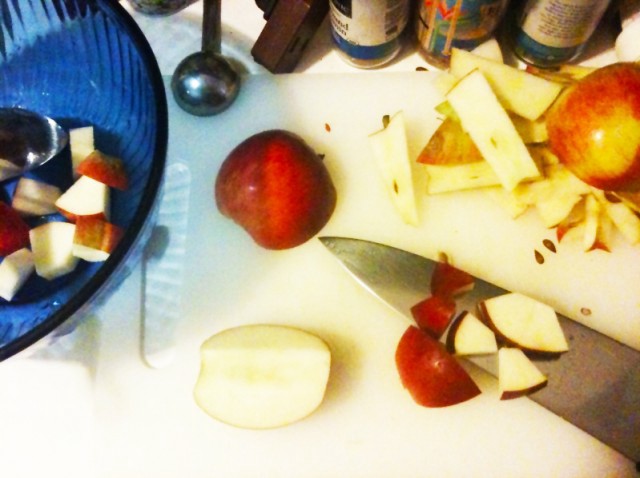
When I set out to make that applesauce last fall, all I wanted to do is use up the apples I brought home from apple picking. Of course, between apple picking and the chance to cook I ate most of the picked apples, so I bought a two-dollar bag of five pounds of apples from the farmers market. (You can get five pounds for two dollars or three pounds for one, which is dubious math.) The apples cooked down more quickly than I expected. I watched the raisins plump up and thought of Danny, the Champion of the World and feeding hidden sleeping pills to pheasants. I felt satisfied, both because of the fruitful expenditure of effort and for the resulting store of applesauce to eat my way through over the winter, which I guess is a very prairie wife way to feel.
How To Make Apple Sauce
Chop some apples — a pound or five — into small cubes. Use lemon juice to keep them from browning. Start the chopped ones cooking while you finish chopping the rest, with maybe a splash of water if they’re too dry at first. Add a few shakes of cinnamon, nutmeg, ginger and a dash of cayenne pepper. Add raisins. Stir every so often, so nothing sticks.
Chop and chop and chop and stir and stir with a wooden spoon standing over the stove, maybe the warmest spot in your apartment if the heat’s not turned on yet.
Imagine a wood-burning stove. Imagine yourself an apron. Imagine yourself a prairie home. Imagine 1865, or so.
Make your house smell like pie.
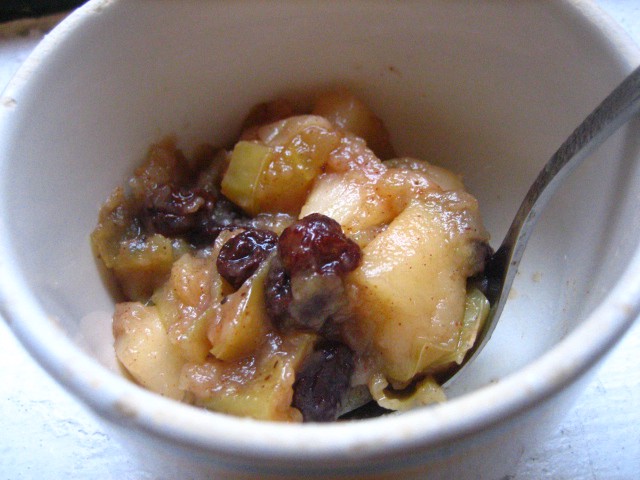
Jaime Green is looking forward to honey cake.
